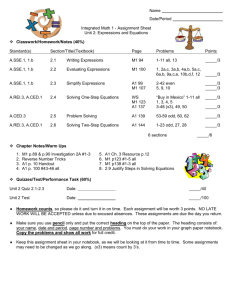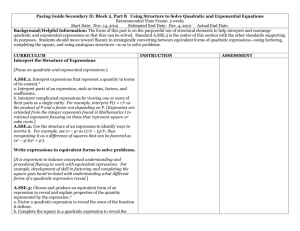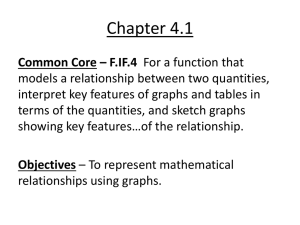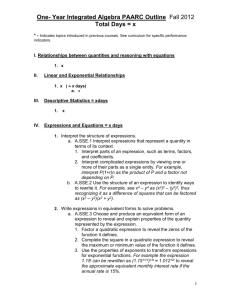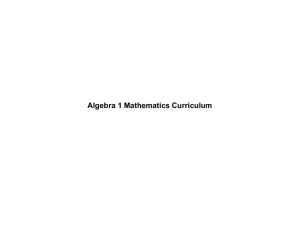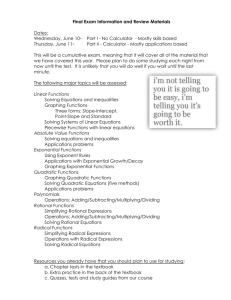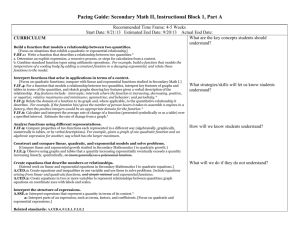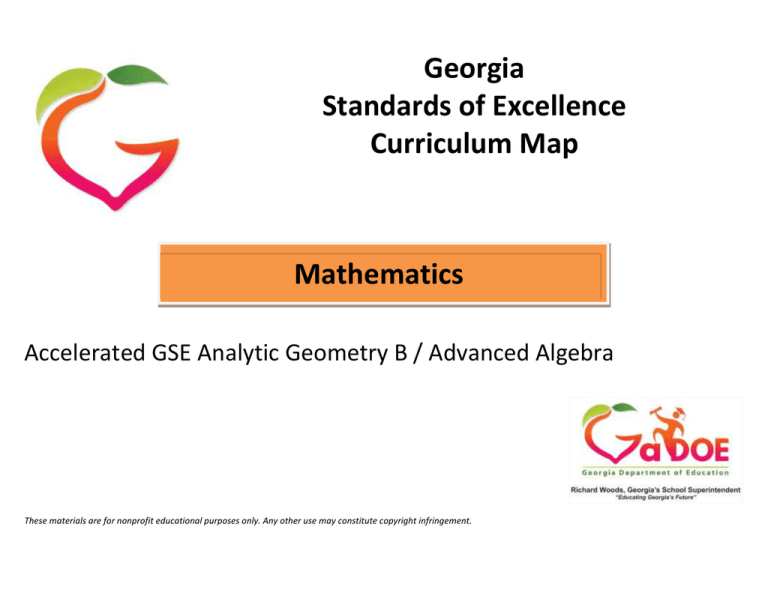
Georgia
Standards of Excellence
Curriculum Map
Mathematics
Accelerated GSE Analytic Geometry B / Advanced Algebra
These materials are for nonprofit educational purposes only. Any other use may constitute copyright infringement.
Georgia Department of Education
Accelerated GSE Analytic Geometry B/Advanced Algebra Curriculum Map
1st Semester
2nd Semester
Unit 1
(5 – 6 weeks)
Unit 2
(2 – 3 weeks)
Unit 3
(3 – 4 weeks)
Unit 4
(2 – 3 weeks)
Unit 5
(2 – 3 weeks)
Unit 6
(3 – 4 weeks)
Unit 7
(4 – 5 weeks)
Unit 8
(3 – 4 weeks)
Unit 9
(3 – 4 weeks)
Quadratic
Functions
Geometric and
Algebraic
Connections
Applications of
Probability
Quadratics
Revisited
Operations
With
Polynomials
Polynomial
Functions
Rational &
Radical
Relationships
Exponential &
Logarithms
Mathematical
Modeling
MGSE9-12.A.SSE.1
MGSE9-12.A.SSE.1a
MGSE9-12.A.SSE.1b
MGSE9-12.A.SSE.2
MGSE9-12.A.SSE.3
MGSE9-12.A.SSE.3a
MGSE9-12.A.SSE.3b
MGSE9-12.A.CED.1
MGSE9-12.A.CED.2
MGSE9-12.A.CED.4
MGSE9-12.A.REI.4
MGSE9-12.A.REI.4a
MGSE9-12.A.REI.4b
MGSE9-12.F.IF.4
MGSE9-12.F.IF.5
MGSE9-12.F.IF.6
MGSE9-12.F.IF.7
MGSE9-12.F.IF.7a
MGSE9-12.F.IF.8
MGSE9-12.F.IF.8a
MGSE9-12.F.IF.9
MGSE9-12.F.BF.1
MGSE9-12.F.BF.1a
MGSE9-12.F.BF.3
MGSE9-12.F.LE.3
MGSE9-12.S.ID.6
MGSE9-12.S.ID.6a
MGSE9-12.G.GPE.1
MGSE9-12.G.GPE.4
MGSE9-12.G.MG.1
MGSE9-12.G.MG.2
MGSE9-12.G.MG.3
MGSE9-12.S.CP.1
MGSE9-12.S.CP.2
MGSE9-12.S.CP.3
MGSE9-12.S.CP.4
MGSE9-12.S.CP.5
MGSE9-12.S.CP.6
MGSE9-12.S.CP.7
MGSE9-12.N.CN.1
MGSE9-12.N.CN.2
MGSE9-12.N.CN.3
MGSE9-12.N.CN.7
MGSE9-12.N.CN.8
MGSE9-12.A.REI.4
MGSE9-12.A.REI.4b
MGSE9-12.N.RN.1
MGSE9-12.N.RN.2
MGSE9-12.A.APR.1
MGSE9-12.A.APR.5
MGSE9-12.A.APR.6
MGSE9-12.F.BF.1
MGSE9-12.F.BF.1b
MGSE9-12.F.BF.1c
MGSE9-12.F.BF.4
MGSE9-12.F.BF.4a
MGSE9-12.F.BF.4b
MGSE9-12.F.BF.4c
MGSE9-12.N.CN.9
MGSE9-12.A.SSE.1
MGSE9-12.A.SSE.1a
MGSE9-12.A.SSE.1b
MGSE9-12.A.SSE.2
MGSE9-12.A.APR.2
MGSE9-12.A.APR.3
MGSE9-12.A.APR.4
MGSE9-12.F.IF.4
MGSE9-12.F.IF.7
MGSE9-12.F.IF.7c
MGSE9-12.A.APR.7
MGSE9-12.A.CED.1
MGSE9-12.A.CED.2
MGSE9-12.A.REI.2
MGSE9-12.F.IF.4
MGSE9-12.F.IF.5
MGSE9-12.F.IF.7
MGSE9-12.F.IF.7b
MGSE9-12.F.IF.7d
MGSE9-12.A.SSE.3
MGSE9-12.A.SSE.3c
MGSE9-12.F.IF.7
MGSE9-12.F.IF.7e
MGSE9-12.F.IF.8
MGSE9-12.F.IF.8b
MGSE9-12.F.BF.5
MGSE9-12.F.LE.4
MGSE9-12.A.SSE.4
MGSE9-12.A.CED.1
MGSE9-12.A.CED.2
MGSE9-12.A.CED.3
MGSE9-12.A.CED.4
MGSE9-12.A.REI.11
MGSE9-12.F.IF.6
MGSE9-12.F.IF.9
MGSE9-12.F.BF.3
These units were written to build upon concepts from prior units, so later units contain tasks that depend upon the concepts addressed in earlier units.
All units will include the Mathematical Practices and indicate skills to maintain.
*Revised standards indicated in bold red font.
NOTE: Mathematical standards are interwoven and should be addressed throughout the year in as many different units and tasks as possible in order to stress the natural connections that exist among mathematical topics.
Grade 9-12 Key:
Number and Quantity Strand: RN = The Real Number System, Q = Quantities, CN = Complex Number System, VM = Vector and Matrix Quantities
Algebra Strand: SSE = Seeing Structure in Expressions, APR = Arithmetic with Polynomial and Rational Expressions, CED = Creating Equations, REI = Reasoning with Equations and Inequalities
Functions Strand: IF = Interpreting Functions, LE = Linear and Exponential Models, BF = Building Functions, TF = Trigonometric Functions
Geometry Strand: CO = Congruence, SRT = Similarity, Right Triangles, and Trigonometry, C = Circles, GPE = Expressing Geometric Properties with Equations, GMD = Geometric Measurement and Dimension,
MG = Modeling with Geometry
Statistics and Probability Strand: ID = Interpreting Categorical and Quantitative Data, IC = Making Inferences and Justifying Conclusions, CP = Conditional Probability and the Rules of Probability, MD = Using Probability
to Make Decisions
Richard Woods, State School Superintendent
July 2105 ● Page 1 of 6
All Rights Reserved
Georgia Department of Education
Accelerated GSE Analytic Geometry B/Advanced Algebra Expanded Curriculum Map – 1st Semester
Standards for Mathematical Practice
5 Use appropriate tools strategically.
6 Attend to precision.
7 Look for and make use of structure.
8 Look for and express regularity in repeated reasoning.
1st Semester
1 Make sense of problems and persevere in solving them.
2 Reason abstractly and quantitatively.
3 Construct viable arguments and critique the reasoning of others.
4 Model with mathematics.
Unit 1
Unit 2
Unit 3
Unit 4
Quadratic Functions
Geometric and Algebraic
Connections
Applications of Probability
Quadratics Revisited
Interpret the structure of expressions
MGSE9-12.A.SSE.1 Interpret expressions that
represent a quantity in terms of its context.
MGSE9-12.A.SSE.1a Interpret parts of an
expression, such as terms, factors, and coefficients,
in context.
MGSE9-12.A.SSE.1b Given situations which utilize
formulas or expressions with multiple terms and/or
factors, interpret the meaning (in context) of
individual terms or factors.
MGSE9-12.A.SSE.2 Use the structure of an
expression to rewrite it in different equivalent
forms.
For example, see x4 – y4 as (x2)2 - (y2)2, thus
recognizing it as a difference of squares that can be
factored as (x2 – y2) (x2 + y2).
Write expressions in equivalent forms to solve
problems
MGSE9-12.A.SSE.3 Choose and produce an
equivalent form of an expression to reveal and explain
properties of the quantity represented by the
expression.
MGSE9-12.A.SSE.3a Factor any quadratic
expression to reveal the zeros of the function
defined by the expression.
MGSE9-12.A.SSE.3b Complete the square in a
quadratic expression to reveal the maximum or
minimum value of the function defined by the
expression.
Create equations that describe numbers or
relationships
MGSE9-12.A.CED.1 Create equations and
inequalities in one variable and use them to solve
problems. Include equations arising from linear,
quadratic, simple rational, and exponential
functions (integer inputs only).
MGSE9-12.A.CED.2 Create linear, quadratic, and
exponential equations in two or more variables to
represent relationships between quantities; graph
equations on coordinate axes with labels and scales.
(The phrase “in two or more variables” refers to
formulas like the compound interest formula, in
Translate between the geometric description
and the equation for a conic section
MGSE9-12.G.GPE.1 Derive the equation of a
circle of given center and radius using the
Pythagorean Theorem; complete the square to
find the center and radius of a circle given by an
equation.
Use coordinates to prove simple geometric
theorems algebraically
MGSE9-12.G.GPE.4 Use coordinates to prove
simple geometric theorems algebraically. For
example, prove or disprove that a figure defined
by four given points in the coordinate plane is a
rectangle; prove or disprove that the point (1, √3)
lies on the circle centered at the origin and
containing the point (0,2).
(Focus on quadrilaterals, right triangles, and
circles.)
Apply geometric concepts in modeling
situations
MGSE9-12.G.MG.1 Use geometric shapes, their
measures, and their properties to describe objects
(e.g., modeling a tree trunk or a human torso as a
cylinder).
MGSE9-12.G.MG.2 Apply concepts of density
based on area and volume in modeling situations
(e.g., persons per square mile, BTUs per cubic
foot).
MGSE9-12.G.MG.3 Apply geometric methods to
solve design problems (e.g., designing an object
or structure to satisfy physical constraints or
minimize cost; working with typographic grid
systems based on ratios).
Understand independence and conditional
probability and use them to interpret data
MGSE9-12.S.CP.1 Describe categories of events
as subsets of a sample space using unions,
intersections, or complements of other events (or,
and, not).
MGSE9-12.S.CP.2 Understand that if two events
A and B are independent, the probability of A
and B occurring together is the product of their
probabilities, and that if the probability of two
events A and B occurring together is the product
of their probabilities, the two events are
independent.
MGSE9-12.S.CP.3 Understand the conditional
probability of A given B as P (A and B)/P(B).
Interpret independence of A and B in terms of
conditional probability; that is the conditional
probability of A given B is the same as the
probability of A and the conditional probability
of B given A is the same as the probability of B.
MGSE9-12.S.CP.4 Construct and interpret twoway frequency tables of data when two categories
are associated with each object being classified.
Use the two-way table as a sample space to decide
if events are independent and to approximate
conditional probabilities. For example, use
collected data from a random sample of students in
your school on their favorite subject among math,
science, and English. Estimate the probability that
a randomly selected student from your school will
favor science given that the student is in tenth
grade. Do the same for other subjects and compare
the results.
MGSE9-12.S.CP.5 Recognize and explain the
concepts of conditional probability and
independence in everyday language and everyday
situations. For example, compare the chance of
having lung cancer if you are a smoker with the
chance of being a smoker if you have lung cancer.
Perform arithmetic operations with complex
numbers.
MGSE9-12.N.CN.1 Understand there is a
complex number i such that i2 = −1, and every
complex number has the form a + bi where a and
b are real numbers.
MGSE9-12.N.CN.2 Use the relation i2 = –1 and the
commutative, associative, and distributive properties
to add, subtract, and multiply complex numbers.
MGSE9-12.N.CN.3 Find the conjugate of a
complex number; use the conjugate to find the
absolute value (modulus) and quotient of
complex numbers.
Use complex numbers in polynomial identities
and equations.
MGSE9-12.N.CN.7 Solve quadratic equations
with real coefficients that have complex solutions
by (but not limited to) square roots, completing
the square, and the quadratic formula.
MGSE9-12.N.CN.8 Extend polynomial identities
to include factoring with complex numbers. For
example, rewrite x2 + 4 as (x + 2i)(x – 2i).
Solve equations and inequalities in one variable
MGSE9-12.A.REI.4 Solve quadratic equations in
one variable.
MGSE9-12.A.REI.4b Solve quadratic equations
by inspection (e.g., for x2 = 49), taking square
roots, factoring, completing the square, and the
quadratic formula, as appropriate to the initial
form of the equation (limit to real number
solutions).
Extend the properties of exponents to rational
exponents.
MGSE9-12.N.RN.1 Explain how the meaning of
rational exponents follows from extending the
properties of integer exponents to rational
numbers, allowing for a notation for radicals in
terms of rational exponents. For example, we
define 5(1/3) to be the cube root of 5 because we
want [5(1/3)]3 = 5[(1/3) x 3] to hold, so [5(1/3)]3 must
equal 5.
MGSE9-12.N.RN.2 Rewrite expressions involving
Use the rules of probability to compute
probabilities of compound events in a uniform
Richard Woods, State School Superintendent
July 2105 ● Page 2 of 6
All Rights Reserved
Georgia Department of Education
which A = P(1 + r/n)nt has multiple variables.)
MGSE9-12.A.CED.4 Rearrange formulas to
highlight a quantity of interest using the same
reasoning as in solving equations. Examples:
Rearrange Ohm’s law V = IR to highlight resistance
R; Rearrange area of a circle formula A = π r2 to
highlight the radius r.
Solve equations and inequalities in one variable
MGSE9-12.A.REI.4 Solve quadratic equations in one
variable.
MGSE9-12.A.REI.4a Use the method of completing
the square to transform any quadratic equation in
x into an equation of the form (x – p)2 = q that has
the same solutions. Derive the quadratic formula
from ax2 + bx + c = 0.
MGSE9-12.A.REI.4b Solve quadratic equations by
inspection (e.g., for x2 = 49), taking square roots,
factoring, completing the square, and the quadratic
formula, as appropriate to the initial form of the
equation (limit to real number solutions).
Interpret functions that arise in applications in
terms of the context
MGSE9-12.F.IF.4 Using tables, graphs, and verbal
descriptions, interpret the key characteristics of a
function which models the relationship between two
quantities. Sketch a graph showing key features
including: intercepts; interval where the function is
increasing, decreasing, positive, or negative;
relative maximums and minimums; symmetries;
end behavior; and periodicity.
MGSE9-12.F.IF.5 Relate the domain of a function to
its graph and, where applicable, to the quantitative
relationship it describes. For example, if the function
h(n) gives the number of person-hours it takes to
assemble n engines in a factory, then the positive
integers would be an appropriate domain for the
function.
MGSE9-12.F.IF.6 Calculate and interpret the average
rate of change of a function (presented symbolically or
as a table) over a specified interval. Estimate the rate
of change from a graph.
Analyze functions using different representations
MGSE9-12.F.IF.7 Graph functions expressed
algebraically and show key features of the graph
both by hand and by using technology.
MGSE9-12.F.IF.7a Graph linear and quadratic
functions and show intercepts, maxima, and
minima (as determined by the function or by
context).
MGSE9-12.F.IF.8 Write a function defined by an
expression in different but equivalent forms to reveal
and explain different properties of the function.
MGSE9-12.F.IF.8a Use the process of factoring and
completing the square in a quadratic function to
show zeros, extreme values, and symmetry of the
graph, and interpret these in terms of a context.
probability model
MGSE9-12.S.CP.6 Find the conditional
probability of A given B as the fraction of B’s
outcomes that also belong to A, and interpret the
answer in context.
MGSE9-12.S.CP.7 Apply the Addition Rule, P(A
or B) = P(A) + P(B) – P(A and B), and interpret
the answers in context.
Richard Woods, State School Superintendent
July 2105 ● Page 3 of 6
All Rights Reserved
radicals and rational exponents using the properties
of exponents.
Georgia Department of Education
For example, compare and contrast quadratic
functions in standard, vertex, and intercept forms.
MGSE9-12.F.IF.9 Compare properties of two
functions each represented in a different way
(algebraically, graphically, numerically in tables, or
by verbal descriptions). For example, given a graph
of one function and an algebraic expression for
another, say which has the larger maximum.
Build a function that models a relationship between
two quantities
MGSE9-12.F.BF.1 Write a function that describes a
relationship between two quantities.
MGSE9-12.F.BF.1a Determine an explicit
expression and the recursive process (steps for
calculation) from context. For example, if Jimmy
starts out with $15 and earns $2 a day, the explicit
expression “2x+15” can be described recursively
(either in writing or verbally) as “to find out how
much money Jimmy will have tomorrow, you add $2
to his total today.” J n J n 1 2, J 0 15
Build new functions from existing functions
MGSE9-12.F.BF.3 Identify the effect on the graph of
replacing f(x) by f(x) + k, k f(x), f(kx), and f(x + k) for
specific values of k (both positive and negative); find
the value of k given the graphs. Experiment with cases
and illustrate an explanation of the effects on the graph
using technology. Include recognizing even and odd
functions from their graphs and algebraic expressions
for them.
Construct and compare linear, quadratic, and
exponential models and solve problems
MGSE9-12.F.LE.3 Observe using graphs and tables
that a quantity increasing exponentially eventually
exceeds a quantity increasing linearly, quadratically, or
(more generally) as a polynomial function.
Summarize, represent, and interpret data on two
categorical and quantitative variables
MGSE9-12.S.ID.6 Represent data on two quantitative
variables on a scatter plot, and describe how the
variables are related.
MGSE9-12.S.ID.6a Decide which type of function is
most appropriate by observing graphed data,
charted data, or by analysis of context to generate a
viable (rough) function of best fit. Use this function
to solve problems in context. Emphasize linear,
quadratic and exponential models.
Richard Woods, State School Superintendent
July 2105 ● Page 4 of 6
All Rights Reserved
Georgia Department of Education
Accelerated GSE Analytic Geometry B/Advanced Algebra Expanded Curriculum Map – 2nd Semester
1 Make sense of problems and persevere in solving them.
2 Reason abstractly and quantitatively.
3 Construct viable arguments and critique the reasoning of others.
4 Model with mathematics.
Standards for Mathematical Practice
5 Use appropriate tools strategically.
6 Attend to precision.
7 Look for and make use of structure.
8 Look for and express regularity in repeated reasoning.
2nd Semester
Unit 5
Unit 6
Unit 7
Unit 8
Unit 9
Operations With Polynomials
Polynomial Functions
Rational & Radical
Relationships
Exponential & Logarithms
Mathematical Modeling
Perform arithmetic operations on
polynomials
MGSE9-12.A.APR.1 Add, subtract,
and multiply polynomials; understand
that polynomials form a system
analogous to the integers in that they
are closed under these operations.
MGSE9-12.A.APR.5 Know and apply
that the Binomial Theorem gives the
expansion of (x + y)n in powers of x
and y for a positive integer n, where x
and y are any numbers, with
coefficients determined for example by
Pascal’s Triangle.
Rewrite rational expressions
MGSE9-12.A.APR.6 Rewrite simple
rational expressions in different forms
using inspection, long division, or a
computer algebra system; write
a(x)/b(x) in the form q(x) + r(x)/b(x),
where a(x), b(x), q(x), and r(x) are
polynomials with the degree of r(x)
less than the degree of b(x).
Build a function that models a
relationship between two quantities
MGSE9-12.F.BF.1 Write a function that
describes a relationship between two
quantities.
MGSE9-12.F.BF.1b Combine
standard function types using
arithmetic operations in contextual
situations (Adding, subtracting, and
multiplying functions of different
types).
MGSE9-12.F.BF.1c Compose functions.
For example, if T(y) is the temperature in
the atmosphere as a function of height,
and h(t) is the height of a weather
balloon as a function of time, then T(h(t))
is the temperature at the location of the
weather balloon as a function of time.
MGSE9-12.N.CN.9 Use the
Fundamental Theorem of Algebra to
find all roots of a polynomial equation
Interpret the structure of expressions
MGSE9-12.A.SSE.1 Interpret
expressions that represent a quantity in
terms of its context.
MGSE9-12.A.SSE.1a Interpret parts
of an expression, such as terms,
factors, and coefficients, in context.
MGSE9-12.A.SSE.1b Given situations
which utilize formulas or expressions
with multiple terms and/or factors,
interpret the meaning (in context) of
individual terms or factors.
MGSE9-12.A.SSE.2 Use the structure
of an expression to rewrite it in
different equivalent forms. For
example, see x4 – y4 as (x2)2 - (y2)2, thus
recognizing it as a difference of
squares that can be factored
as (x2 – y2) (x2 + y2).
Understand the relationship between
zeros and factors of polynomials
MGSE9-12.A.APR.2 Know and apply
the Remainder Theorem: For a
polynomial p(x) and a number a, the
remainder on division by x – a is p(a), so
p(a) = 0 if and only if (x – a) is a factor
of p(x).
MGSE9-12.A.APR.3 Identify zeros of
polynomials when suitable factorizations
are available, and use the zeros to
construct a rough graph of the function
defined by the polynomial.
Use polynomial identities to solve
problems
MGSE9-12.A.APR.4 Prove
Rewrite rational expressions
MGSE9-12.A.APR.7 Understand that
rational expressions form a system
analogous to the rational numbers, closed
under addition, subtraction,
multiplication, and division by a nonzero
rational expression; add, subtract,
multiply, and divide rational expressions.
Create equations that describe
numbers or relationships
MGSE9-12.A.CED.1 Create equations
and inequalities in one variable and
use them to solve problems. Include
equations arising from linear,
quadratic, simple rational, and
exponential functions (integer inputs
only).
MGSE9-12.A.CED.2 Create linear,
quadratic, and exponential equations
in two or more variables to represent
relationships between quantities;
graph equations on coordinate axes
with labels and scales. (Limit to
rational and radical functions. The
phrase “in two or more variables”
refers to formulas like the compound
interest formula, in which A = P(1 +
r/n)nt has multiple variables.)
Understand solving equations as a
process of reasoning and explain the
reasoning
MGSE9-12.A.REI.2 Solve simple
rational and radical equations in one
variable, and give examples showing
how extraneous solutions may arise.
MGSE9-12.F.IF.4 Using tables,
graphs, and verbal descriptions,
interpret the key characteristics of a
function which models the relationship
between two quantities. Sketch a
graph showing key features including:
Write expressions in equivalent forms
to solve problems
MGSE9-12.A.SSE.3 Choose and
produce an equivalent form of an
expression to reveal and explain
properties of the quantity represented by
the expression.
MGSE9-12.A.SSE.3c Use the
properties of exponents to transform
expressions for exponential functions.
For example, the expression 1.15t ,
where t is in years, can be rewritten as
[1.15(1/12)](12t) ≈ 1.012(12t) to reveal the
approximate equivalent monthly interest
rate is 15%.
Analyze functions using different
representations
MGSE9-12.F.IF.7 Graph functions
expressed algebraically and show key
features of the graph both by hand
and by using technology.
MGSE9-12.F.IF.7e Graph exponential
and logarithmic functions, showing
intercepts and end behavior, and
trigonometric functions, showing period,
midline, and amplitude.
MGSE9-12.F.IF.8 Write a function
defined by an expression in different but
equivalent forms to reveal and explain
different properties of the function.
MGSE9-12.F.IF.8b Use the properties
of exponents to interpret expressions for
exponential functions. For example,
identify percent rate of change in
functions such as y = (1.02)t, y = (0.97)t,
y = (1.01)(12t), y = (1.2)(t/10), and classify
them as representing exponential growth
and decay.
Write expressions in equivalent forms
to solve problems
MGSE9-12.A.SSE.4 Derive the formula
for the sum of a finite geometric series
(when the common ratio is not 1), and
use the formula to solve problems. For
example, calculate mortgage payments.
MGSE9-12.A.CED.1 Create equations
and inequalities in one variable and
use them to solve problems. Include
equations arising from linear,
quadratic, simple rational, and
exponential functions (integer inputs
only).
MGSE9-12.A.CED.2 Create linear,
quadratic, and exponential equations
in two or more variables to represent
relationships between quantities;
graph equations on coordinate axes
with labels and scales. (The phrase “in
two or more variables” refers to
formulas like the compound interest
formula, in which A = P(1 + r/n)nt has
multiple variables.)
MGSE9-12.A.CED.3 Represent
constraints by equations or
inequalities, and by systems of
equation and/or inequalities, and
interpret data points as possible (i.e. a
solution) or not possible (i.e. a nonsolution) under the established
constraints.
MGSE9-12.A.CED.4 Rearrange
formulas to highlight a quantity of
interest using the same reasoning as in
solving equations. Examples:
Rearrange Ohm’s law V = IR to
highlight resistance R; Rearrange area
of a circle formula A = π r2 to highlight
the radius r.
Represent and solve equations and
polynomial identities and use them
to describe numerical relationships.
For example, the polynomial
Richard Woods, State School Superintendent
July 2105 ● Page 5 of 6
All Rights Reserved
Build new functions from existing
functions
Georgia Department of Education
Build new functions from existing
functions
MGSE9-12.F.BF.4
Find
inverse
functions.
MGSE9-12.F.BF.4a Solve an equation
of the form f(x) = c for a simple function
f that has an inverse and write an
expression for the inverse. For example,
f(x) =2(x3) or f(x) = (x+1)/(x-1) for x ≠
1.
MGSE9-12.F.BF.4b Verify by
composition that one function is the
inverse of another.
MGSE9-12.F.BF.4c Read values of an
inverse function from a graph or a table,
given that the function has an inverse.
identity (x2 + y2)2 = (x2 – y2)2 +
(2xy)2 can be used to generate
Pythagorean triples.
Interpret functions that arise in
applications in terms of the context
MGSE9-12.F.IF.4
Using
tables,
graphs, and verbal descriptions,
interpret the key characteristics of a
function which models the relationship
between two quantities. Sketch a
graph showing key features including:
intercepts; interval where the function
is increasing, decreasing, positive, or
negative; relative maximums and
minimums; symmetries; end behavior;
and periodicity.
Analyze functions using different
representations
MGSE9-12.F.IF.7 Graph functions
expressed algebraically and show key
features of the graph both by hand
and by using technology.
MGSE9-12.F.IF.7c Graph polynomial
functions, identifying zeros when
suitable factorizations are available, and
showing end behavior.
intercepts; interval where the function
is increasing, decreasing, positive, or
negative; relative maximums and
minimums; symmetries; end behavior;
and periodicity.
Interpret functions that arise in
applications in terms of the context
MGSE9-12.F.IF.5 Relate the domain of
a function to its graph and, where
applicable, to the quantitative
relationship it describes. For example, if
the function h(n) gives the number of
person-hours it takes to assemble n
engines in a factory, then the positive
integers would be an appropriate domain
for the function.
Analyze functions using different
representations
MGSE9-12.F.IF.7 Graph functions
expressed algebraically and show key
features of the graph both by hand
and by using technology.
MGSE9-12.F.IF.7b Graph square root,
cube root, and piecewise-defined
functions, including step functions and
absolute value functions.
MGSE9-12.F.IF.7d Graph rational
functions, identifying zeros and
asymptotes when suitable factorizations
are available, and showing end behavior.
Richard Woods, State School Superintendent
July 2105 ● Page 6 of 6
All Rights Reserved
MGSE9-12.F.BF.5 Understand the
inverse relationship between exponents
and logarithms and use this relationship
to solve problems involving logarithms
and exponents.
Construct and compare linear,
quadratic, and exponential models and
solve problems
MGSE9-12.F.LE.4 For exponential
models, express as a logarithm the
solution to ab(ct) = d where a, c, and d are
numbers and the base b is 2, 10, or e;
evaluate the logarithm using technology.
inequalities graphically
MGSE9-12.A.REI.11 Using graphs,
tables, or successive approximations,
show that the solution to the equation
f(x) = g(x) is the x-value where the yvalues of f(x) and g(x) are the same.
Interpret functions that arise in
applications in terms of the context
MGSE9-12.F.IF.6
Calculate
and
interpret the average rate of change of a
function (presented symbolically or as a
table) over a specified interval. Estimate
the rate of change from a graph.
MGSE9-12.F.IF.9 Compare properties
of two functions each represented in a
different way (algebraically,
graphically, numerically in tables, or
by verbal descriptions). For example,
given a graph of one function and an
algebraic expression for another, say
which has the larger maximum.
Build new functions from existing
functions
MGSE9-12.F.BF.3 Identify the effect on
the graph of replacing f(x) by f(x) + k, k
f(x), f(kx), and f(x + k) for specific
values of k (both positive and negative);
find the value of k given the graphs.
Experiment with cases and illustrate an
explanation of the effects on the graph
using technology. Include recognizing
even and odd functions from their graphs
and algebraic expressions for them.

